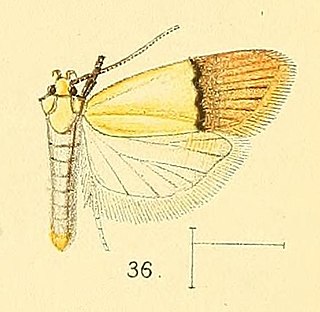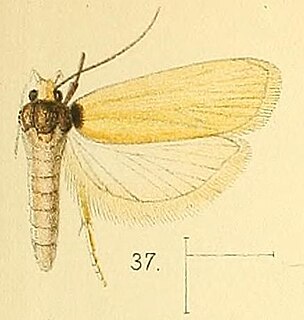Machimia caduca is a moth in the family Depressariidae. It was described by Walsingham in 1912. It is found in Guatemala.
Dichomeris piperatus is a moth in the family Gelechiidae. It was described by Walsingham in 1892. It is found in the West Indies, where it has been recorded from St. Vincent, Puerto Rico and Cuba.
Dichomeris percnopolis is a moth in the family Gelechiidae. It was described by Walsingham in 1911. It is found in Guatemala.

Eunebristis oncotera is a moth in the family Gelechiidae. It was described by Walsingham in 1911. It is found in Mexico (Guerrero).
Helcystogramma trigonella is a moth in the family Gelechiidae. It was described by Walsingham in 1892. It is found in the West Indies.
Aristotelia pantalaena is a moth of the family Gelechiidae. It was described by Walsingham in 1911. It is found in Mexico (Tabasco).

Ornativalva erubescens is a moth of the family Gelechiidae. It was described by Walsingham in 1904. It is found in Morocco, Algeria, Tunisia, Libya, Egypt, Sudan, Israel, Saudi Arabia, Iran, Pakistan, and the southwestern U.S.
Glyphidocera elpista is a moth in the family Autostichidae. It was described by Walsingham in 1911. It is found in Panama.
Gonioterma fastigata is a moth of the family Depressariidae. It is found in Guyana.
Protolychnis maculata is a moth in the family Lecithoceridae. It was described by Walsingham in 1881. It is found in the Democratic Republic of Congo (Orientale), Namibia, South Africa, Tanzania and Zimbabwe.
Psittacastis stigmaphylli is a moth in the family Depressariidae. It was described by Lord Walsingham in 1912. It is found on Jamaica.

Odites natalensis is a moth in the family Depressariidae. It was described by Lord Walsingham in 1891. It is found in the Republic of the Congo, the Democratic Republic of the Congo (Katanga), Malawi, Mozambique, South Africa (KwaZulu-Natal), Tanzania and Zimbabwe.

Odites carterella is a moth in the family Depressariidae. It was described by Lord Walsingham in 1891. It is found in Gambia.
Antaeotricha ceratistes is a moth in the family Depressariidae. It was described by Lord Walsingham in 1912. It is found in Mexico (Guerrero).
Antaeotricha admixta is a moth in the family Depressariidae. It was described by Lord Walsingham in 1913. It is found in Mexico (Guerrero).
Antaeotricha forreri is a moth in the family Depressariidae. It was described by Lord Walsingham in 1913. It is found in Panama and Mexico (Durango).
Antaeotricha stigmatias is a moth in the family Depressariidae. It was described by Lord Walsingham in 1913. It is found in Guatemala.
Cerconota palliata is a moth in the family Depressariidae. It was described by Lord Walsingham in 1913. It is found in Guatemala.
Stenoma symmicta is a moth in the family Depressariidae. It was described by Lord Walsingham in 1913. It is found in Panama and Guyana.
Stenoma lavata is a moth in the family Depressariidae. It was described by Lord Walsingham in 1913. It is found in Tabasco, Mexico.




